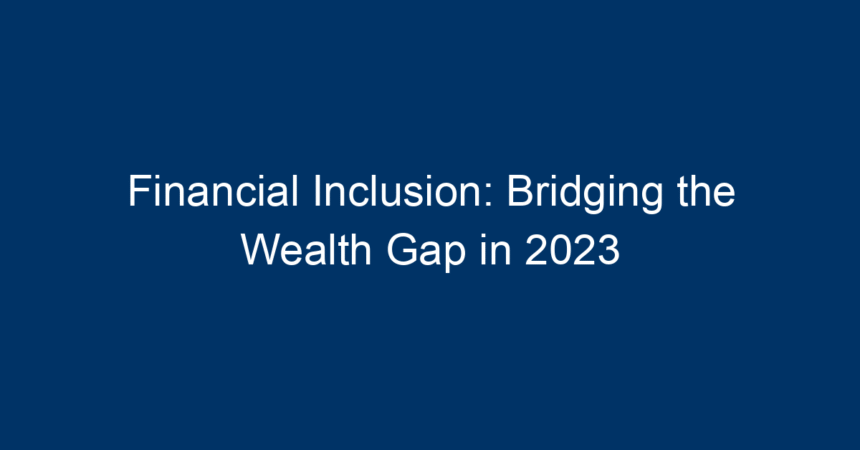In an increasingly interconnected world, the disparities in wealth remain stark and concerning. In 2023, the concept of financial inclusion has emerged as a powerful tool in combating poverty and inequality, striving to ensure that everyone—regardless of their socioeconomic status—has access to financial services. This article delves into the current landscape of financial inclusion, its significance, challenges, and actionable insights to bridge the wealth gap, ultimately creating a more equitable economic environment.
Understanding Financial Inclusion
Financial inclusion refers to the provisioning of affordable and accessible financial services to individuals and businesses, particularly those who are typically underserved or excluded from the traditional banking system. This includes access to banking accounts, credit, insurance, and investment products. The goal of financial inclusion is to empower individuals and communities economically, fostering a more stable and equitable society.
The Importance of Financial Inclusion
-
Empowerment of Individuals: Financial inclusion allows individuals to take control of their economic futures. By providing access to bank accounts and credit, people can save money, invest in education, or start businesses.
-
Economic Growth: When more people participate in the economy, it leads to increased demand for goods and services. This, in turn, stimulates job creation and sustainable economic growth.
-
Reduction of Poverty: Financial services enable low-income families to manage their finances more effectively. Access to credit, savings accounts, and insurance can help families cope with unexpected expenses or emergencies.
- Enhanced Gender Equality: Women, in particular, often face barriers to financial services. Promoting financial inclusion can empower women economically, enabling them to contribute to their households and communities.
Current Trends in Financial Inclusion (2023)
Digital Financial Services
One of the most significant trends in 2023 is the rise of digital financial services. With the proliferation of smartphones and the internet, fintech companies are offering innovative solutions that break down traditional barriers to finance. Mobile banking, e-wallets, and payment platforms are now commonplace, allowing individuals in remote areas to access financial services conveniently and affordably.
Government Initiatives
Governments around the world are increasingly recognizing the importance of financial inclusion and are launching initiatives aimed at improving access. Programs such as cash transfers, subsidies, and microfinance are being implemented to support low-income populations. Policies that promote digital identification also play a critical role in enhancing inclusivity.
Collaborations with NGOs
Non-governmental organizations (NGOs) are vital in advancing financial inclusion efforts. By partnering with financial institutions, NGOs can provide education and resources to underserved populations. This collaboration often results in more tailored solutions that address unique community needs.
Barriers to Financial Inclusion
Despite progress, significant barriers to financial inclusion persist.
Lack of Awareness
Many individuals remain unaware of the available financial services. In underserved communities, financial literacy is often low, preventing people from understanding their options and the benefits of financial inclusion.
Regulatory Challenges
Complex regulatory environments can hinder the growth of fintech solutions. In some regions, outdated regulations limit the ability of innovative companies to operate, preventing them from reaching those in need of financial services.
Digital Divide
While digital financial services are a growing trend, the digital divide remains a challenge. In many low-income regions, limited internet access and inadequate infrastructure restrict the ability of individuals to utilize these services.
Strategies to Enhance Financial Inclusion
To bridge the wealth gap effectively, targeted strategies must be implemented.
1. Promote Financial Literacy
Education is key. Governments, NGOs, and financial institutions must prioritize financial literacy programs to educate communities about the importance of saving, budgeting, and utilizing financial services. Workshops, online courses, and community outreach can help demystify finance for underserved populations.
2. Leverage Technology
Investing in technology can expand access to financial services. Mobile banking apps, fintech solutions, and blockchain technology offer innovative ways to reach individuals who are unbanked or underbanked. For instance, using biometric identification can help include those without formal documentation.
3. Strengthen Regulatory Frameworks
Regulatory bodies need to adapt to the evolving financial landscape. Simplifying compliance processes and promoting inclusive policies can encourage fintech development and create a more welcoming environment for financial innovation.
4. Foster Public-Private Partnerships
Collaboration between the public and private sectors is crucial. By working together, governments and private companies can develop solutions tailored to the needs of underserved communities. Financial institutions can leverage government support to reduce the risks of lending to low-income individuals.
The Role of Technology in Financial Inclusion
Mobile Banking and Fintech Solutions
Mobile banking has significantly revolutionized financial inclusion. In many parts of the world, especially in Africa and Asia, mobile applications allow users to manage their finances without the need for traditional banking infrastructure. Fintech companies provide innovative products that cater specifically to the underserved, including microloans and peer-to-peer lending platforms.
Blockchain Technology
Blockchain offers the potential to provide secure, transparent financial services, even to those without access to traditional banking. By facilitating transactions without intermediaries, blockchain can lower costs and enhance access to financial services.
Artificial Intelligence
AI-driven financial solutions can personalize services based on individual needs and behaviors, enhancing customer experience. AI can also help financial institutions assess risk more efficiently, enabling them to lend to individuals who might otherwise be excluded.
Case Studies: Successful Financial Inclusion Initiatives
M-Pesa in Kenya
M-Pesa is a prime example of successful financial inclusion through mobile banking. Launched in 2007, it has transformed the financial landscape in Kenya, allowing millions to transfer money, pay bills, and access loans using their mobile phones. This initiative has empowered countless individuals and small businesses.
Grameen Bank in Bangladesh
Founded by Nobel Laureate Muhammad Yunus, Grameen Bank focuses on microfinance to promote entrepreneurship among the poor. By providing small loans to individuals, especially women, the bank has successfully lifted many families out of poverty, demonstrating the power of financial inclusion.
Conclusion: Taking Action Towards Financial Inclusion
As we move further into 2023, the call for financial inclusion has never been more urgent. It’s not merely a matter of access to financial services, but also a fundamental aspect of social justice and economic development.
Actionable Insights:
-
Engage in Community Education: Support local programs that promote financial literacy and empower individuals to make informed financial decisions.
-
Advocate for Policy Changes: Engage with policymakers to encourage the development of inclusive financial policies that enable innovation and access.
-
Support Fintech Solutions: Seek out and utilize fintech solutions that offer affordable financial services, contributing to the growth of inclusive finance.
- Collaborate and Innovate: If you are part of a company or organization, consider how partnerships can bridge the gap between underserved communities and financial services.
Final Thoughts
Financial inclusion is not just a buzzword but a powerful remedy to the growing wealth divide. By prioritizing education, leveraging technology, and fostering collaboration, we can create a more inclusive economic environment where everyone has the opportunity to prosper. Embrace these strategies and join the movement towards a financially inclusive world, bridging the wealth gap for a brighter future.




